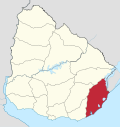|
Punta del Diablo
Punta del Diablo is a village and seaside locality in Uruguay, Rocha Department, 298 kilometres (185 mi) east from the capital Montevideo. According to the 2011 census, its permanent population consisted of 823 inhabitants, mostly fishermen and artisans, while during high tourism season, the population swells to approximately 25,000, mostly with Argentinians, Brazilians and Europeans on holiday. As with the country it is located in, the primary language spoken in Punta del Diablo is Spanish. In 2008 it was named by the magazine "Lonely Planet" as one of the top 20 places to visit and invest. PopulationIn 2011 Punta del Diablo had a population of 823.[1]
Source: Instituto Nacional de Estadística de Uruguay[2] GeographyThe village of Punta Del Diablo is situated 298 kilometres (185 mi) from Montevideo, the capital of Uruguay, 172 kilometres (107 mi) from the upscale seaside resort town of Punta del Este, and 43 km from Chuy (which borders the Brazil city of Chuí). Punta Del Diablo is perched on a gentle rise overlooking the ocean and centered around a square of brightly colored buildings, including houses, shops, restaurants, bars, shops and grocery stores that line sandy lanes.[3] Due to strict building codes, there are no high rises or sprawling luxury resorts or high rises. Instead there are small hotels, a boutique hostel, cabanas and vacation houses.[3] The white sands of the beach below are separated by the main rocky point, "Punta Del Diablo," which extends more than 600 feet, and two other rocky points, together forming "The Trident." ClimatePunta del Diablo is in the Southern Hemisphere's temperate zone and has four seasons. Temperatures average 21 to 27 °C (70 to 81 °F) in summer and 10 and 16 °C (50 and 61 °F) in winter. TourismThe high season for tourism runs from December through February, as well as through Easter week. During high season, the population of the small fishing and artisan village of approximately 400 people, grows to approximately 25,000.[citation needed] Tourists rent homes and cabanas or stay in hostels and small hotels. Most of the hotels and hostels are open only during the high season; however, some are open year-round to accommodate the increasing number of visitors to the seaside village. In response several restaurants including fine-dining options are also open off-season.[4] In 2008, Lonely Planet ranked Punta del Diablo among the top 10 cities to visit. During that year, tourism was up to about 20,000 visitors during the December to February seasonal peak.[3] Punta del Diablo's popularity with holidaymakers has steadily increased. And the single farming family that has owned the entirety of Punta del Diablo has been steadily selling land to investors.[5] This tourism growth and Uruguay's positive investment climate and rule of law are attractive to foreign investors. Foreign investors are treated the same as national investors, prior authorization is not required, and they enjoy fully free remittance of capital and profits. Uruguay itself is host to about 100 American firms with investments totaling approximately $656 million; and the small village of Punta del Diablo has attracted a steady stream of American and other foreign investors.[6] Places of interest
ActivitiesHorseback Riding. Year round, visitors can rent horse or take guided horseback riding tours on the beach or in the forest.[citation needed] Dune boarding. Similar to snow boarding only done on the sand dunes. The surf shop in Punta del Diablo sells dune boards. Popular locations in Punta del Diablo for sand duning include the south end of La Viuda beach.[citation needed] Surfing. The surf breaks off Punta Diablo's beaches offer relatively consistent and uncrowded surf. Best conditions are in the autumn and winter with high season running from December to February.[9] Visitors can rent or purchase surf boards at the Surf Shop on, Main Road.[10] TransportIt is about an hour's walk from one end of the town to another. There is a regular bus service that transports people from the main village road to the beach. There is a taxi, which often parks at the bus stop. Punta del Diablo has regular bus service to Chuy (bordering Brazil), Rocha and Montevideo. During the summer, there is service to the seaside towns of La Paloma, La Piedra, and Punta del Este. During the high season of tourism, January, all bus seats are sometimes booked days in advance. Car rentals are found in Montevideo. Going into Punta del Diablo, some of the buses go into town and others drop off passengers about 5 km from town at a square from which dirt roads fan out to various parts of the village. It is about a 3 ½ bus ride from Montevideo. References
External linksWikivoyage has a travel guide for Punta del Diablo. |
||||||||||||||||||||||||||||||||||||
Portal di Ensiklopedia Dunia


